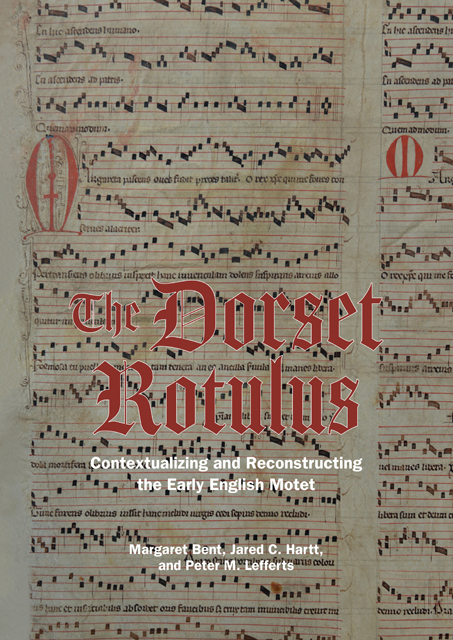Book contents
- Frontmatter
- Contents
- List of Figures
- List of Music Examples
- List of Tables
- Abbreviations
- Note on the Transcriptions
- Introduction
- 1 The Source and its Contents
- 2 Contexts and Designs
- 3 Voice-Exchange Motets and Ascendenti sonet geminacio/ Viri Galilei
- 4 Margareta pascens oves and its Large-Scale Comparands
- 5 Rota versatilis: Towards a Reconstruction
- 6 The Curious Case of Regina preminencie/ Gemma nitens/ … mater es intacta
- 7 Introducing Naufragantes visita/ Navigatrix inclita/ T. Aptatur/ … velox perpetrat
- 8 The Musical Rotulus: Artifact, Image, and Attributes
- 9 Epilogue: Conclusions and Speculation
- Appendix: Transcriptions, Texts, and Translations of the Four Dorset Motets
- Bibliography
- Index of Manuscripts
- Index of Musical Compositions
- General Index
- Studies in Medieval and Renaissance Music
3 - Voice-Exchange Motets and Ascendenti sonet geminacio/ Viri Galilei
Published online by Cambridge University Press: 14 January 2023
- Frontmatter
- Contents
- List of Figures
- List of Music Examples
- List of Tables
- Abbreviations
- Note on the Transcriptions
- Introduction
- 1 The Source and its Contents
- 2 Contexts and Designs
- 3 Voice-Exchange Motets and Ascendenti sonet geminacio/ Viri Galilei
- 4 Margareta pascens oves and its Large-Scale Comparands
- 5 Rota versatilis: Towards a Reconstruction
- 6 The Curious Case of Regina preminencie/ Gemma nitens/ … mater es intacta
- 7 Introducing Naufragantes visita/ Navigatrix inclita/ T. Aptatur/ … velox perpetrat
- 8 The Musical Rotulus: Artifact, Image, and Attributes
- 9 Epilogue: Conclusions and Speculation
- Appendix: Transcriptions, Texts, and Translations of the Four Dorset Motets
- Bibliography
- Index of Manuscripts
- Index of Musical Compositions
- General Index
- Studies in Medieval and Renaissance Music
Summary
Voice-exchange motets piqued the imaginations of composers in England, as is attested by the variety of unique features and compositional approaches exhibited in the numerous extant examples of this type of motet. The two Dor motets Ascendenti sonet geminacio/ Viri Galilei and Margareta pascens oves demonstrate aspects of this remarkable variety, and highlight English composers’ affinity for experimentation, not only within the broad genre of the motet, but specifically in the crafting of voice-exchange motets. The discovery of the Dor rotulus prompts a fresh examination of the surviving voice-exchange motets from the early fourteenth century. Ascendenti/Viri, a motet with relatively short sections of exchange, along with many of its comparands, will be the focus here; the much larger motet Margareta and several related compositions will be treated in Chapters 4 and 5.
This chapter discusses salient textual, musical, and structural features of Ascendenti/Viri, and offers a reconstruction of its missing portions. To contextualize the motet – and in response to the fact that most of the voice-exchange motets have not been granted any attention since Lefferts’s work on them in the 1980s – the following also examines five comparable compositions. These works each exhibit unique characteristics, illustrating the high degree of compositional innovation present in the repertory. First though, what is a voice-exchange motet? The opening phrases of Ascendenti/Viri provide a glimpse.
Sections I and II of Ascendenti/Viri
Ascendenti/Viri, a motet on the Ascension, unfolds in six sections of uniform length (16L each) and concludes with a brief coda (4L). The first two sections of the motet appear in Example 3.1. The text in Cantus I begins by celebrating Christ’s Ascension into heaven: ‘For him that ascendeth, let paired trumpets resound together with dancing’ (‘Ascendenti sonet geminacio | tubarum resonancium cum tripudio’). The last syllable of the rhyming words ‘geminacio’ and ‘tripudio’ divide this 8L period into two, each marked by a long, at 4 and 8. Cantus II sings only for half of the time, its two entrances coinciding with the last ‘o’ syllable of Cantus I’s eleven- and thirteen-syllable lines: the voice first enters at 4, addressing ‘Ye men of Galilei’ (‘Viri Galilei’), and then at 8 asks those men, Jesus’s apostles, ‘why do ye wonder?’ (‘quid vos admiramini?’).
- Type
- Chapter
- Information
- The Dorset RotulusContextualizing and Reconstructing the Early English Motet, pp. 57 - 106Publisher: Boydell & BrewerPrint publication year: 2021



